RECOLLECTIONS
OF THE WALTHER
COMPANY'S VENTURE INTO ELECTRONICS
by
Ray Mackay
|
Disclaimer http://www.dotpoint.com/xnumber/walther.htm Any correspondence to the author can be made at file:///C|/waltherweb/highlander@i.net.au |
|||||||||
|
In
the earlier article we explained how the introduction of electronics
started to affect mechanical calculator manufacturers. The
manufacturers seemed unaware of what was taking place and of the
revolution that was to strike the industry. Manufacturers of fine
machinery such as Walther endeavoured to make the necessary changes.
Some other manufacturers, such as H.W. Egli (MADAS), as far as I am
aware, didn't even try to follow or even understand what was about
to take place. Others, at first endeavoured to adopt to change but
soon realised the massive changes, intellectually and manufacturing
wise (plant re investments etc) that would be necessary. |
|||||||||
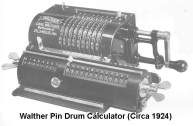 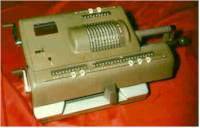 I
believe Walther started manufacturing mechanical machines using the
Odhner Wheel 'Pin Drum' system. N.C.M had a similar beginning and
documents at hand claim that in 1967 they had a prior fifty year
history. It is known that in 1965 they were still manufacturing the
HL-21 (see illustration on the right). Both Companies started
manufacturing electronic office machines in the mid sixties. One can
assume research started early in the sixties. The author's first
contact with Busicom Corporation (N.C.M) was as they introduced their
electronic machines in 1967. His association with Walther was
considerably longer starting with the introduction, by Walther, of the
Comptograph 101 to the English speaking world and, in particular,
Australia. An exact date is not known but circa the late fifties would
not be unreasonable. Thus one could say that the author was actually
present as Walther explored the possibilities of changing from
mechanical calculators to the new breed 'electronic calculators' I
believe Walther started manufacturing mechanical machines using the
Odhner Wheel 'Pin Drum' system. N.C.M had a similar beginning and
documents at hand claim that in 1967 they had a prior fifty year
history. It is known that in 1965 they were still manufacturing the
HL-21 (see illustration on the right). Both Companies started
manufacturing electronic office machines in the mid sixties. One can
assume research started early in the sixties. The author's first
contact with Busicom Corporation (N.C.M) was as they introduced their
electronic machines in 1967. His association with Walther was
considerably longer starting with the introduction, by Walther, of the
Comptograph 101 to the English speaking world and, in particular,
Australia. An exact date is not known but circa the late fifties would
not be unreasonable. Thus one could say that the author was actually
present as Walther explored the possibilities of changing from
mechanical calculators to the new breed 'electronic calculators' |
|||||||||
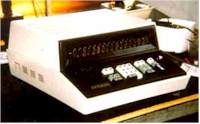 In the
meantime other manufacturers, were already involved in the manufacture
of mechanical machines. Japanese, American and European manufacturers
of various mechanical machines, such as Liebnitz and Odhner type
machines including key driven mechanical machines started to
experience difficulties selling them, some closed down very quickly as
'they saw the writing on the wall'. Other tried to adapt and develop
electronic machines. One such manufacturer was NCM (Nippon Computing
Machinery commonly referred to as Busicom Corporation). This company
introduced the machine on the right, a Busicom 161 in 1967. It
consisted entirely of discrete components and typically contained four
or five flip-flops per board and there were forty-two PC boards in
this machine. It had core memory in the form of a platrix array 16
bits X 16 bits which was made by Mitsubishi. The display was a printed
circuit board on which there were 16 Nixie Tubes mounted in parallel
with individual anodes. Solidly constructed out of aluminum frame and
steel case the unit almost required a wheel barrow to move it around.
The printed circuit boards were single sided paper phenolic and I
suspect this beginning was responsible for a number of mistakes in
early Japanese construction; more about this later In the
meantime other manufacturers, were already involved in the manufacture
of mechanical machines. Japanese, American and European manufacturers
of various mechanical machines, such as Liebnitz and Odhner type
machines including key driven mechanical machines started to
experience difficulties selling them, some closed down very quickly as
'they saw the writing on the wall'. Other tried to adapt and develop
electronic machines. One such manufacturer was NCM (Nippon Computing
Machinery commonly referred to as Busicom Corporation). This company
introduced the machine on the right, a Busicom 161 in 1967. It
consisted entirely of discrete components and typically contained four
or five flip-flops per board and there were forty-two PC boards in
this machine. It had core memory in the form of a platrix array 16
bits X 16 bits which was made by Mitsubishi. The display was a printed
circuit board on which there were 16 Nixie Tubes mounted in parallel
with individual anodes. Solidly constructed out of aluminum frame and
steel case the unit almost required a wheel barrow to move it around.
The printed circuit boards were single sided paper phenolic and I
suspect this beginning was responsible for a number of mistakes in
early Japanese construction; more about this later |
|||||||||
Imagine the situation faced by resellers of
office equipment faced with this newcomer. Mechanical machines were
forced to sit alongside the new electronic counterparts. Fortunately,
in the beginning the new machines were bulky and heavy. In addition
operators had become accustomed to the resistance offered to their
touch on mechanical machines; such resistance was not evident on the
new electronic machines. Resistance of another type was evident by the
technical and administrative personnel of various companies. Firstly
technical staff of many companies were going to need extensive
re-training. Office managers felt threatened by this new technology
just as many older managers still feel threatened by personal
computers. Operators couldn't adopt to a room full of silence as
opposed to the sound and rhythm of a room full of the clatter of
mechanical machines. One assumes noise equated to work in the eys of
management also, the competitive spirit of a room full of ‘busy
bee’ Comptometrists built an association and feeling of being a team
member: Not withstanding any of this the seed of the new technology,
the new kid on the block, was born. Resistance of another type was evident by the
technical and administrative personnel of various companies. Firstly
technical staff of many companies were going to need extensive
re-training. Office managers felt threatened by this new technology
just as many older managers still feel threatened by personal
computers. Operators couldn't adopt to a room full of silence as
opposed to the sound and rhythm of a room full of the clatter of
mechanical machines. One assumes noise equated to work in the eys of
management also, the competitive spirit of a room full of ‘busy
bee’ Comptometrists built an association and feeling of being a team
member: Not withstanding any of this the seed of the new technology,
the new kid on the block, was born. |
|||||||||
 Manufacturers
like Walther were forced to rethink their position and at first they
adopted the discrete component approach using many discrete component
and large heavy duty printed circuit boards. This made the first
endeavours cumbersome and heavy to move. Early endeavours with
electronic versions of the electronic calculator required sizable
desktop real estate due to the size of the machines. Manufacturers
like Walther were forced to rethink their position and at first they
adopted the discrete component approach using many discrete component
and large heavy duty printed circuit boards. This made the first
endeavours cumbersome and heavy to move. Early endeavours with
electronic versions of the electronic calculator required sizable
desktop real estate due to the size of the machines.
This was however a transitory period and manufacturers like Walther at first endeavoured to create electronic machine by emulating the working patterns of mechanical machines but using electronics in place of mechanical parts. Many a time we experienced a mixture of both technologies. |
|||||||||
 Circa
1971 we saw the first signs of Walther going
electronic when they accepted an order from the 'Deutschhen Bundesbahn"
for a ticketing system that was to be electronic. This system was
early in the electronic era and communications as we know of them now
were not available. Certainly there would be little, if any,
electronic networking. Circa
1971 we saw the first signs of Walther going
electronic when they accepted an order from the 'Deutschhen Bundesbahn"
for a ticketing system that was to be electronic. This system was
early in the electronic era and communications as we know of them now
were not available. Certainly there would be little, if any,
electronic networking.The machines were bulky, used large power supplies two boards logic boards were linked by jumper cables. The componentry was mostly TTL (Transistor Transistor Logic) and discrete components with a few special IC's thrown in to the mixture. To the author this was exciting stuff... here were the machines he could only dream of working with in his early electronic days.
|
|||||||||
|
|||||||||
|
The new technology was developing merging photographic techniques whereby film could be processed with ultra high resolution images. Photographers like Willy Butler developed chemicals that process film with unprecedented clarity. Camera lenses were developed to the stage where they had superb resolution with negligible distortion. This was absolutely essential if many images were to be overlaid and superimposed. Each layer represented a particular 'doped' or etched layer as the 'wafer' was created. Using a method of depositing various layers on a substrate, consisting of insulating and conducting layers on silicon ‘multiple transistors’, ‘gates’ and flip-flops along with other electronic components were created and the previous 6X 4" board holding four flip-flops was condensed down to a silicon wafer around 2mm square.. Thus a further part of an equation was falling into place. |
|||||||||
|
Discrete devices had given away to small integrated devices, made by photographing drawings of integrated layouts on to film. Reproducing the large detailed images on to various masks that could be reduced and replicated for screening on substrates such as silicon cut in to wafer thin slices. As each layer was deposited it was 'doped' with gases and the end result was what looked like a solid chip of silicon with all the component parts that previously consisted of discrete devices. It is important to gain a perspective as to the direction in which these moves were going. A normal 2 state flip-flop consisted of, at least, two transistors, eight resistors, two or four capacitors and varying numbers of diodes. Four such flip-flops could occupy a printed circuit board some 6 X 4 inches. The introduction of early commercially produced IC's by companies such as Fairchild and Signetics et al placed all four devices and additional gates on a small integrated circuit. Many such 'chips were then mounted on printed circuit boards it became possible to mount enough discrete 'Chips' on a board some nine inches by 3 inches and a few such boards could do more, and often better, than what the earlier monsters did. Not only were power supply requirements less, reducing bulk but the footprint was more acceptable; giving the operator his/her desktop space back for documents etc. |
|||||||||
|
|||||||||
| Within a
very short time the discrete IC moved upwards and became a single
device containing many of the earlier circuits and was justifiably
called an MSI (Medium Size Integration). The very name suggests that
larger integration was already possible. Around 1965 to 1970 NRMEC
(North American Rockwell Micro Electronics Corporation - 'Autonetics'
Division) was working on techniques to build large size integrated
circuits for the NASA (North American Space Administration) projects.
These devices were required to be miniaturised for the rocket control
and computing devices of the future. Government contracts allowed
‘spin off’ and many companies gained expertise and advantages. The
skills of the various companies are well documented. As the author is
only familiar, in the main, with NRMEC and early Rockwell you will
note a bias to this area of knowledge. Though the author is familiar
with calculator developments by Texas Instruments he is laying the
foundations for the revolution about to take place and its impact on
Walther and possibly mankind in general. In this respect parallel
moves by other manufacturers such as Fairchild and Signetics, just to
name two of a plethora of companies, are being deliberately ignored
as, though such impacted greatly on specific manufacturers dealing
with each IC manufacturer and fabrication facility, they did not
necessarily directly influenced the developments by Walther. As an aside it should be mentioned that technicians left Fairchild and formed separate Company to liaison with Busicom. This liaison with Mr Kojima of Busicom ultimately culminated in the development of the microprocessor. It is also a fact that the first Fairchild IC specification sheets were handed to Mr Hideo Aoyama of Busicom by the author (1967). Who knows :- this early information could have lead to the larger liaisons over the coming years. This however is another story and documented elsewhere on this web site. Back to Walther. |
|||||||||
|
|||||||||
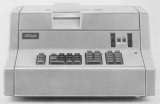 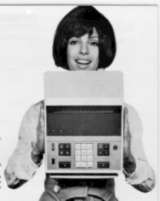 The early samples of Walther’s endeavours sat on
the shelf unused. Demonstrations in Australia made little impact. In
the meantime the Busicom changed from the Busicom 161 to the Busicom
162, a device using only about eight boards and built mostly of
Fairchild and Signetics MSI technology. The size and weight was only
half that of the earlier machines. Here the Japanese manufacturer made
a basic mistake based, one assumes, on cost. The Printed circuit board
designs dictated complexity with tracks on both sides of the board.
Computer aided design replaced hand layout on Mylar using black tape.
Tracks located on both sides of the board required plated hole
technology. To joint tracks on each side, the Japanese manufacturer (NCM)
used paper phenolic boards and poked wire through the holes for
soldering on each side on early released units. It would have been a
labour intensive process and subject to cold (badly) soldered joints.
Also paper phenolic is not as stable as epoxy and thus the boards
developed ‘track faults’ between the layers. Walther appeared to
battle on favourably and used the better quality Epoxy boards. Firstly
a model ETR10 desktop model with printer and then a portable model
called the ETR-1. Obviously smaller machines were required if one
required acceptance by the operators of the day. Later the Japanese
adopted epoxy boards, however in the early days assembly of boards was
still ‘outsourced, to local Japanese ladies who hand soldered
components onto the circuit boards.
Automatic computerized assembly only came later. The early samples of Walther’s endeavours sat on
the shelf unused. Demonstrations in Australia made little impact. In
the meantime the Busicom changed from the Busicom 161 to the Busicom
162, a device using only about eight boards and built mostly of
Fairchild and Signetics MSI technology. The size and weight was only
half that of the earlier machines. Here the Japanese manufacturer made
a basic mistake based, one assumes, on cost. The Printed circuit board
designs dictated complexity with tracks on both sides of the board.
Computer aided design replaced hand layout on Mylar using black tape.
Tracks located on both sides of the board required plated hole
technology. To joint tracks on each side, the Japanese manufacturer (NCM)
used paper phenolic boards and poked wire through the holes for
soldering on each side on early released units. It would have been a
labour intensive process and subject to cold (badly) soldered joints.
Also paper phenolic is not as stable as epoxy and thus the boards
developed ‘track faults’ between the layers. Walther appeared to
battle on favourably and used the better quality Epoxy boards. Firstly
a model ETR10 desktop model with printer and then a portable model
called the ETR-1. Obviously smaller machines were required if one
required acceptance by the operators of the day. Later the Japanese
adopted epoxy boards, however in the early days assembly of boards was
still ‘outsourced, to local Japanese ladies who hand soldered
components onto the circuit boards.
Automatic computerized assembly only came later. |
|||||||||
|
|||||||||
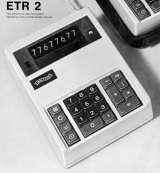 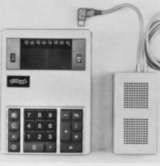 I'm not certain if, in retaliation, by design or
merely by evolution, Walther produced two portables of their own. An
ETR-2 and ETR-3 The first a mains driven and the second completely
portable, with a large 'Varta'
rechargeable battery. The unit was packed in a neat leather carrying
case. The machines certainly went through an evolutionary process.
Firstly using a six chip calculator chipset by Philips of Eindhoven
followed by a compatible chipset from Electronic Arrays of America the
chipsets were later reduced to only four chips in the 'FDY series' and
later a two chip print out chipset which was also produced by
Electronic Arrays. (details of the cross relationship in FDY chipsets
is available from the author).The six chipset models were to be the
only small portable type machines that the author saw from Walther.
Other machines although classified as portable were more in the class
of small desktop calculators that could be carried from desk to desk.
A sameness became noticeable among various calculators. As changes
took place they seemed to take place across the board and almost
simultaneously by all manufacturers. Styles seemed to follow a trend
however the Walther stuck to its guns with the style that had been
introduced with the later models of mechanical machines, such as the
Comptess and Diwa machines. These new machines were very versatile and
the style was unique with brightly coloured key tops and squarish
structure. An excellent site at www.devidts.com/be-calc/desk_12856.html
contains unbelievable detailed photos of this model. I also note that
other sites now contain detailed information on the ETR series written
about below. I'm not certain if, in retaliation, by design or
merely by evolution, Walther produced two portables of their own. An
ETR-2 and ETR-3 The first a mains driven and the second completely
portable, with a large 'Varta'
rechargeable battery. The unit was packed in a neat leather carrying
case. The machines certainly went through an evolutionary process.
Firstly using a six chip calculator chipset by Philips of Eindhoven
followed by a compatible chipset from Electronic Arrays of America the
chipsets were later reduced to only four chips in the 'FDY series' and
later a two chip print out chipset which was also produced by
Electronic Arrays. (details of the cross relationship in FDY chipsets
is available from the author).The six chipset models were to be the
only small portable type machines that the author saw from Walther.
Other machines although classified as portable were more in the class
of small desktop calculators that could be carried from desk to desk.
A sameness became noticeable among various calculators. As changes
took place they seemed to take place across the board and almost
simultaneously by all manufacturers. Styles seemed to follow a trend
however the Walther stuck to its guns with the style that had been
introduced with the later models of mechanical machines, such as the
Comptess and Diwa machines. These new machines were very versatile and
the style was unique with brightly coloured key tops and squarish
structure. An excellent site at www.devidts.com/be-calc/desk_12856.html
contains unbelievable detailed photos of this model. I also note that
other sites now contain detailed information on the ETR series written
about below. |
|||||||||
|
The
last three machines
were ETR-21 : ETR-25 and ETR-1032S respectively, although there was
an ETR24 somewhere in the line up I don't have an illustration. The
ETR 1032S being a single chip machine using single Rockwell 15350 42
pin quad in line calculator chip. Excluding the power supply and the
'special' display there were only eight diodes and two resistors in
the machine; the lowest component count the author had ever seen.
In spite of attractive design and low manufacturing costs the machines were replaced, at least in the Australian market, by Casio and others and the author moved on to supplying competitive machines by the Japanese manufacturers. There was nothing wrong in this, it is just that there is a sadness that accompanies a dying era. Firstly one missed the smell of machine oil and the sound of a finely tuned mechanism. One also feels sad when a particular manufacturer, in spite of an excellent product was forced to stop challenging the market because the competition appears to be taking over his domain. In retrospect I still feel Walther would still have been marketing desk top calculators had they just had that little bit of extra tenacity. Of course hindsight offers us options we never saw at the time. |
|||||||||
|
|||||||||
| One can see certain parallels between various manufacturers and is forced to wonder if there is a relationship as the IC and LSI manufacturers used their fabrication factory sales personnel to sell to all comers. Did various IC manufacturers look up existing mechanical calculator manufacturers in an endeavour to get rapid inroads to readily available client databases and thus existing markets?. If so their plans were obviously a success. | |||||||||
| Walther started
manufacturing mechanical machines using the Odhner Wheel 'Pin Drum'
system. N.C.M had a similar beginning and documents on hand claim that
in 1967 they had a prior fifty year history. It is known that in 1965
they were still manufacturing the HL-21 (see illustration above, early
in the article). They both started in electronic office machines early
in the piece. Both introduced discrete technology devices. They both
evolved to the use of discrete integrated circuits such as the
Fairchild Diode Transistor Logic, Signetics Transistor logic and
evolved to the use of MSI's (Medium Size IC's). They progressed
through Multiple LSI calculators and on the Micro-processor
calculators. Walther with the Rockwell LSI and Busicom with the Intel
4004. Both appear to have stopped manufacturing around the same time. Electronic
companies, with no prior mechanical calculator experience that started
during the initial early days of electronic calculators, such as
Casio, Sharp, TI, and so on survived even though they had to break in
to new markets. The firmly established mechanical calculator
manufacturer, whom one would expect already had a firmly established
client base, appears to have missed something from the equation.
History takes on a new colour in retrospect and one wonders how one
will see the current market in relation to the personal computer
market in thirty tears time. We already have electronic (e-books)
capable of holding hundreds of literary classics at any one time and
capable of global searches, will they eventually read the text to us
making reading unnecessary?, whoops! that's already been done with the
talking book tape recorder. Will we have shirt pocket computers we can
talk to similar to Dick Tracy's wrist watch?. I guess it is on the
cards and I would love to be around to see what happens. Maybe the
machine controlled man is not that far away and with experiments in
bioelectronic technologies we could even see the half robot half man
products depicted in Hollywood's movies. With the current genome maps
will we see an integration of chemical and electronic devices? Could
it be that man’s intelligence could be re-inforced by large in built
bio-electronic databases on massive size integrated bio-chips? |
|||||||||
|
|||||||||
|
Since first
starting to write the above, along with articles on the Comptometer,
MADAS and Walther mechanical calculators (you can see these at :- http://www.dotpoint.com/xnumber
) the author has discovered Walther still manufactures in One day, if there is sufficient interest, I may write of my experiences with NCM (Busicom) in the late sixties, early seventies. Mr Kojima now manufactures communication devices and Mr Hideo Aoyama is, sadly, no longer with us. Other Busicom people have, over the years, dropped out of touch. |
|||||||||
Recognition is given to all registered trademarks in the above text. Where proprietary information is divulged acknowledgement is given to the respective parties. The material may be used for historic purpose and review but may not be used for commercial gain. |
|||||||||
| Copyright © September 2003 Ray Mackay All rights reserved ® 2003 | |||||||||
Updated July 26, 2004